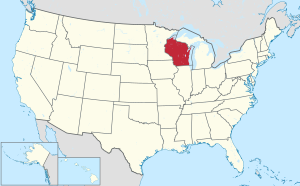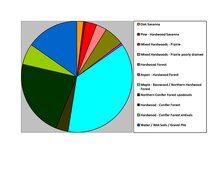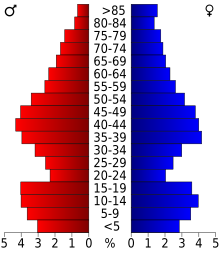County in Wisconsin
| Polk County | |
|---|---|
| County | |
 Old Polk County Courthouse and Museum Old Polk County Courthouse and Museum | |
 Location within the U.S. state of Wisconsin Location within the U.S. state of Wisconsin | |
 Wisconsin's location within the U.S. Wisconsin's location within the U.S. | |
| Coordinates: 45°28′N 92°26′W / 45.46°N 92.44°W / 45.46; -92.44 | |
| Country | |
| State | |
| Founded | 1853 |
| Named for | James K. Polk |
| Seat | Balsam Lake |
| Largest city | Amery |
| Area | |
| • Total | 956 sq mi (2,480 km) |
| • Land | 914 sq mi (2,370 km) |
| • Water | 42 sq mi (110 km) 4.4% |
| Population | |
| • Total | 44,977 |
| • Estimate | 45,762 |
| • Density | 49.2/sq mi (19.0/km) |
| Time zone | UTC−6 (Central) |
| • Summer (DST) | UTC−5 (CDT) |
| Congressional district | 7th |
| Website | www |
Polk County is a county in the U.S. state of Wisconsin. As of the 2020 census, the population was 44,977. Its county seat is Balsam Lake. The county was created in 1853 and named for United States President James K. Polk.
History
After the Wisconsin Territory was established in 1836, large amounts of American Indian territories were ceded to the United states via the White Pine Treaty, formally known as the treaty of St. Peters, much of the land was covered in vast pine forests, and logging activates began soon after.
Geography

According to the U.S. Census Bureau, the county has an area of 956 square miles (2,480 km), of which 914 square miles (2,370 km) is land and 42 square miles (110 km) (4.4%) is water.
Adjacent counties
- Burnett County - north
- Barron County - east
- Dunn County - southeast
- St. Croix County - south
- Washington County, Minnesota - southwest
- Chisago County, Minnesota - west
Major highways
Railroads
Buses
Airports
- Amery Municipal Airport (KAHH) serves the county and surrounding communities.
- L.O. Simenstad Municipal Airport (KOEO).
National protected area
Interstate Park (Wisconsin)
Main article: Interstate ParkEstablished in 1900, the Interstate park is apart of the Saint Croix National Scenic riverway, the Ice Age National Scientific Reserve and is the western most point of the Ice Age National Scenic Trail.
Demographics
| Census | Pop. | Note | %± |
|---|---|---|---|
| 1860 | 1,400 | — | |
| 1870 | 3,422 | 144.4% | |
| 1880 | 10,018 | 192.8% | |
| 1890 | 12,968 | 29.4% | |
| 1900 | 17,801 | 37.3% | |
| 1910 | 21,367 | 20.0% | |
| 1920 | 26,870 | 25.8% | |
| 1930 | 26,567 | −1.1% | |
| 1940 | 26,197 | −1.4% | |
| 1950 | 24,944 | −4.8% | |
| 1960 | 24,968 | 0.1% | |
| 1970 | 26,666 | 6.8% | |
| 1980 | 32,351 | 21.3% | |
| 1990 | 34,773 | 7.5% | |
| 2000 | 41,319 | 18.8% | |
| 2010 | 44,205 | 7.0% | |
| 2020 | 44,977 | 1.7% | |
| U.S. Decennial Census 1790–1960 1900–1990 1990–2000 2010 2020 | |||
2020 census
As of the census of 2020, the population was 44,977. The population density was 49.2 people per square mile (19.0 people/km). There were 24,129 housing units at an average density of 26.4 units per square mile (10.2 units/km). The racial makeup of the county was 93.5% White, 0.9% Native American, 0.5% Asian, 0.4% Black or African American, 0.8% from other races, and 3.9% from two or more races. Ethnically, the population was 2.1% Hispanic or Latino of any race.
2000 census

As of the 2000 census, there were 41,319 people, 16,254 households, and 11,329 families residing in the county. The population density was 45 people per square mile (17 people/km). There were 21,129 housing units at an average density of 23 units per square mile (8.9 units/km). The racial makeup of the county was 97.64% White, 0.15% Black or African American, 1.06% Native American, 0.26% Asian, 0.02% Pacific Islander, 0.20% from other races, and 0.67% from two or more races. 0.80% of the population were Hispanic or Latino of any race. 31.4% were of German, 18.6% Norwegian, 11.3% Swedish, 5.5% Irish and 5.3% American ancestry.
There were 16,254 households, out of which 32.10% had children under the age of 18 living with them, 58.20% were married couples living together, 7.40% had a female householder with no husband present, and 30.30% were non-families. 25.20% of all households were made up of individuals, and 10.60% had someone living alone who was 65 years of age or older. The average household size was 2.51 and the average family size was 3.01.
In the county, the population was spread out, with 26.20% under the age of 18, 6.70% from 18 to 24, 27.70% from 25 to 44, 24.30% from 45 to 64, and 15.10% who were 65 years of age or older. The median age was 39 years. For every 100 females there were 99.90 males. For every 100 females age 18 and over, there were 98.50 males.
In 2017, there were 400 births, giving a general fertility rate of 56.0 births per 1000 women aged 15–44, the 14th lowest rate out of all 72 Wisconsin counties.
Education
Communities

Cities
Villages
- Balsam Lake (county seat)
- Centuria
- Clayton
- Clear Lake
- Dresser
- Frederic
- Luck
- Milltown
- Osceola
- Turtle Lake (mostly in Barron County)
Towns
- Alden
- Apple River
- Balsam Lake
- Beaver
- Black Brook
- Bone Lake
- Clam Falls
- Clayton
- Clear Lake
- Eureka
- Farmington
- Garfield
- Georgetown
- Johnstown
- Laketown
- Lincoln
- Lorain
- Luck
- McKinley
- Milltown
- Osceola
- St. Croix Falls
- Sterling
- West Sweden
Census-designated place
Unincorporated communities
- Atlas
- Bunyan
- Clam Falls
- Cushing
- Deronda
- East Farmington
- Eureka Center
- Fox Creek
- Horse Creek
- Indian Creek
- Joel
- Lamar
- Little Falls
- Lykens
- McKinley
- Nye
- Pole Cat Crossing (partial)
- Range
- Richardson
- Sand Lake
- Ubet
- Wanderoos
- West Denmark
- West Sweden
- Wolf Creek
Notable residents
- Arnold Franz Brasz (1888–1966), a prominent painter, sculptor, and printmaker was born in Polk County on July 19, 1888
- George A. Nelson (1873–1962), the 1936 Socialist Party of America nominee for vice president of the United States, was born in rural Polk County and was a dairy farmer there.
Politics
| Year | Republican | Democratic | Third party(ies) | |||
|---|---|---|---|---|---|---|
| No. | % | No. | % | No. | % | |
| 2024 | 18,296 | 64.83% | 9,567 | 33.90% | 359 | 1.27% |
| 2020 | 16,611 | 62.99% | 9,370 | 35.53% | 390 | 1.48% |
| 2016 | 13,810 | 60.72% | 7,565 | 33.26% | 1,370 | 6.02% |
| 2012 | 12,094 | 53.58% | 10,073 | 44.62% | 406 | 1.80% |
| 2008 | 11,282 | 49.83% | 10,876 | 48.03% | 485 | 2.14% |
| 2004 | 12,095 | 51.46% | 11,173 | 47.54% | 235 | 1.00% |
| 2000 | 9,557 | 48.36% | 8,961 | 45.34% | 1,244 | 6.29% |
| 1996 | 5,387 | 32.82% | 8,334 | 50.78% | 2,692 | 16.40% |
| 1992 | 5,446 | 30.14% | 7,746 | 42.86% | 4,879 | 27.00% |
| 1988 | 6,866 | 42.98% | 8,981 | 56.22% | 128 | 0.80% |
| 1984 | 8,106 | 49.82% | 8,034 | 49.38% | 129 | 0.79% |
| 1980 | 7,207 | 44.23% | 7,607 | 46.68% | 1,482 | 9.09% |
| 1976 | 6,159 | 41.27% | 8,485 | 56.85% | 280 | 1.88% |
| 1972 | 6,567 | 52.40% | 5,738 | 45.78% | 228 | 1.82% |
| 1968 | 5,583 | 48.83% | 5,179 | 45.30% | 671 | 5.87% |
| 1964 | 3,754 | 34.12% | 7,215 | 65.57% | 34 | 0.31% |
| 1960 | 6,387 | 55.23% | 5,148 | 44.51% | 30 | 0.26% |
| 1956 | 5,894 | 54.04% | 4,985 | 45.71% | 27 | 0.25% |
| 1952 | 6,966 | 61.74% | 4,274 | 37.88% | 42 | 0.37% |
| 1948 | 3,974 | 41.52% | 5,330 | 55.68% | 268 | 2.80% |
| 1944 | 5,329 | 53.58% | 4,489 | 45.14% | 127 | 1.28% |
| 1940 | 6,031 | 53.62% | 4,979 | 44.27% | 238 | 2.12% |
| 1936 | 3,596 | 34.25% | 5,618 | 53.51% | 1,285 | 12.24% |
| 1932 | 3,425 | 37.10% | 5,421 | 58.72% | 386 | 4.18% |
| 1928 | 6,905 | 75.14% | 2,177 | 23.69% | 108 | 1.18% |
| 1924 | 2,793 | 37.57% | 317 | 4.26% | 4,324 | 58.17% |
| 1920 | 4,796 | 80.47% | 752 | 12.62% | 412 | 6.91% |
| 1916 | 2,080 | 51.21% | 1,713 | 42.17% | 269 | 6.62% |
| 1912 | 848 | 27.14% | 830 | 26.56% | 1,447 | 46.30% |
| 1908 | 2,788 | 72.02% | 816 | 21.08% | 267 | 6.90% |
| 1904 | 2,985 | 85.55% | 296 | 8.48% | 208 | 5.96% |
| 1900 | 2,735 | 77.48% | 694 | 19.66% | 101 | 2.86% |
| 1896 | 2,861 | 74.56% | 891 | 23.22% | 85 | 2.22% |
| 1892 | 1,477 | 60.33% | 585 | 23.90% | 386 | 15.77% |
From its founding in 1853 through 1928, Polk County was a strongly Republican county in presidential elections, never once backing the Democratic candidate. The only two times in that span it did not support the Republican candidate were in 1912 when former Republican Theodore Roosevelt won the county as the Progressive candidate and in 1924 when Progressive and native Wisconsinite Robert M. La Follette won the county. Then, between 1932 and 2012, Polk County was a very consistently competitive county that leaned slightly Republican. Only two candidates in that span won at least 60% of the county's vote, Dwight D. Eisenhower in his 1952 landslide and Lyndon B. Johnson in his 1964 landslide. Polk County took a rightward turn in 2016, when Donald Trump won over 60% of the county's vote with a winning margin of over 27%, the best margin of victory in the county since 1928 with the exception of Johnson in 1964. Trump won in 2020 with the exact same margin of victory of over 27% while increasing his vote share to nearly 63%. In 2024, Trump once again improved on his previous performance, taking nearly 65% of Polk County's vote and defeating Kamala Harris by more than a 30% margin.
See also
- National Register of Historic Places listings in Polk County, Wisconsin
- St. Croix Chippewa Indians of Wisconsin
References
- Chicago and North Western Railway Company (1908). A History of the Origin of the Place Names Connected with the Chicago & North Western and Chicago, St. Paul, Minneapolis & Omaha Railways. p. 163.
- ^ "2020 Decennial Census: Polk County, Wisconsin". data.census.gov. U.S. Census Bureau. Retrieved July 7, 2022.
- "Find a County". National Association of Counties. Retrieved June 7, 2011.
- "Wisconsin: Individual County Chronologies". Wisconsin Atlas of Historical County Boundaries. The Newberry Library. 2007. Archived from the original on April 14, 2017. Retrieved August 15, 2015.
- "Jams, Dams, Pines and Pigs: Reflections on the St. Croix Logging Era". St. Croix 360. June 12, 2014. Retrieved November 20, 2024.
- Nelson, Steven (2011). Savanna Soils of Minnesota. Minnesota: Self. pp. 61 - 64. ISBN 978-0-615-50320-2.
- "2010 Census Gazetteer Files". United States Census Bureau. August 22, 2012. Retrieved August 8, 2015.
- "Interstate Park | Wisconsin DNR". dnr.wisconsin.gov. Retrieved November 19, 2024.
- "U.S. Decennial Census". United States Census Bureau. Retrieved August 8, 2015.
- "Historical Census Browser". University of Virginia Library. Retrieved August 8, 2015.
- Forstall, Richard L., ed. (March 27, 1995). "Population of Counties by Decennial Census: 1900 to 1990". United States Census Bureau. Retrieved August 8, 2015.
- "Census 2000 PHC-T-4. Ranking Tables for Counties: 1990 and 2000" (PDF). United States Census Bureau. April 2, 2001. Archived (PDF) from the original on October 9, 2022. Retrieved August 8, 2015.
- "State & County QuickFacts". United States Census Bureau. Archived from the original on September 5, 2015. Retrieved January 23, 2014.
- "County Population Totals: 2010-2020". Retrieved June 20, 2021.
- "U.S. Census website". United States Census Bureau. Retrieved May 14, 2011.
- "Annual Wisconsin Birth and Infant Mortality Report, 2017 P-01161-19 (June 2019): Detailed Tables". Archived from the original on June 19, 2019. Retrieved June 20, 2019.
- Leip, David. "Dave Leip's Atlas of U.S. Presidential Elections". uselectionatlas.org. Retrieved February 8, 2021.
Further reading
- Prentice, Worthy A. Reminiscences of Early Pioneer Days in Polk County. Balsam Lake, Wis,: Polk County Ledger, n.d..
External links
- Polk County website
- Polk County map from the Wisconsin Department of Transportation
- Polk County Economic Development Corporation
- Polk County Tourism
| Places adjacent to Polk County, Wisconsin | ||||||||||||||||
|---|---|---|---|---|---|---|---|---|---|---|---|---|---|---|---|---|
| ||||||||||||||||
| Municipalities and communities of Polk County, Wisconsin, United States | ||
|---|---|---|
| County seat: Balsam Lake | ||
| Cities |  | |
| Villages | ||
| Towns | ||
| CDP | ||
| Unincorporated communities | ||
| Indian reservations | ||
| Footnotes | ‡This populated place also has portions in an adjacent county or counties | |
45°28′N 92°26′W / 45.46°N 92.44°W / 45.46; -92.44
Categories:

